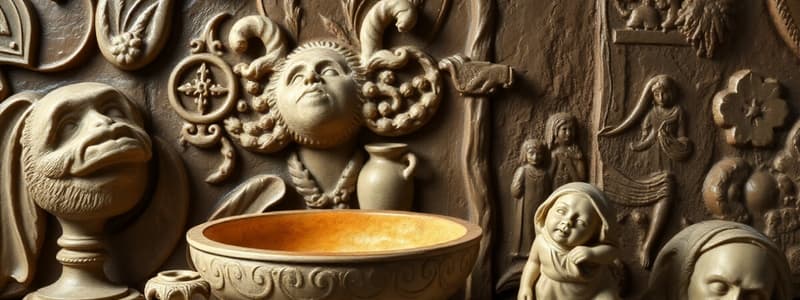Podcast
Questions and Answers
What is the primary purpose of the sprue base in a metal casting process?
What is the primary purpose of the sprue base in a metal casting process?
- To control the temperature of the liquid metal
- To serve as a reservoir for the metal, reducing momentum (correct)
- To increase the fluidity of the molten metal
- To direct the flow of metal into the gate
Which statement correctly defines the volume flow rate in relation to the sprue?
Which statement correctly defines the volume flow rate in relation to the sprue?
- Volume flow rate is calculated using the formula Q = A + v.
- Volume flow rate is dependent solely on the velocity of the liquid metal.
- Volume flow rate does not affect the quality of the final casting.
- Volume flow rate is determined by the cross-sectional area and velocity of the liquid. (correct)
In the context of sprue design, what is the difference between a straight sprue and a tapered sprue?
In the context of sprue design, what is the difference between a straight sprue and a tapered sprue?
- A tapered sprue causes more turbulence than a straight sprue.
- A straight sprue allows for higher speed than a tapered sprue.
- A straight sprue requires less cross-sectional area than a tapered sprue.
- A tapered sprue provides better control of metal flow compared to a straight sprue. (correct)
What does low pressure in the corners of the sprue refer to?
What does low pressure in the corners of the sprue refer to?
Which component is primarily responsible for controlling the flow of molten metal into the casting mold?
Which component is primarily responsible for controlling the flow of molten metal into the casting mold?
What is the primary purpose of a shrinkage allowance in pattern making?
What is the primary purpose of a shrinkage allowance in pattern making?
How does the pattern differ from the final casting?
How does the pattern differ from the final casting?
Which type of allowance is given to facilitate the removal of the pattern from the mould?
Which type of allowance is given to facilitate the removal of the pattern from the mould?
What happens to the pattern material when molten metal is poured into the mould?
What happens to the pattern material when molten metal is poured into the mould?
Which of the following types of shrinkage occurs due to temperature reduction from pouring temperature to liquid point temperature?
Which of the following types of shrinkage occurs due to temperature reduction from pouring temperature to liquid point temperature?
Which allowance is related to the precision of the final dimensions after machining?
Which allowance is related to the precision of the final dimensions after machining?
What is meant by 'pattern allowances'?
What is meant by 'pattern allowances'?
Which of the following is NOT one of the allowed pattern allowances mentioned?
Which of the following is NOT one of the allowed pattern allowances mentioned?
Which characteristic makes plastic a preferred material in casting?
Which characteristic makes plastic a preferred material in casting?
Which factor influences the selection of pattern material based on the size of casting?
Which factor influences the selection of pattern material based on the size of casting?
What is the primary use of a split pattern?
What is the primary use of a split pattern?
Which type of pattern is characterized by having no joints or loose pieces?
Which type of pattern is characterized by having no joints or loose pieces?
What advantage do match-plate patterns provide in casting?
What advantage do match-plate patterns provide in casting?
Which type of pattern is typically used for making castings with projections or undercuts?
Which type of pattern is typically used for making castings with projections or undercuts?
Which type of pattern is best suited for mass production involving multiple cavities in one mold?
Which type of pattern is best suited for mass production involving multiple cavities in one mold?
What material are disposable patterns typically made from?
What material are disposable patterns typically made from?
What is the primary function of a runner in the casting process?
What is the primary function of a runner in the casting process?
What role does a riser play in the casting process?
What role does a riser play in the casting process?
Why is it important for a riser to be the last part to solidify?
Why is it important for a riser to be the last part to solidify?
What creates pressure within a riser during the filling of a mould?
What creates pressure within a riser during the filling of a mould?
Which of the following statements about gates in a mould is accurate?
Which of the following statements about gates in a mould is accurate?
What is a key requirement for the volume of a riser?
What is a key requirement for the volume of a riser?
What characteristic must be maintained in the metal inside the riser?
What characteristic must be maintained in the metal inside the riser?
Which type of riser is described as a vertical channel that remains open to the atmosphere?
Which type of riser is described as a vertical channel that remains open to the atmosphere?
What does the continuity law express regarding the flow of liquid during pouring?
What does the continuity law express regarding the flow of liquid during pouring?
How is the time to fill a mold cavity calculated?
How is the time to fill a mold cavity calculated?
What does Chvorinov's rule relate to in casting?
What does Chvorinov's rule relate to in casting?
If the cross-sectional area at the base of a sprue increases, what happens to the velocity of the flowing metal?
If the cross-sectional area at the base of a sprue increases, what happens to the velocity of the flowing metal?
Which of the following is true about casting defects?
Which of the following is true about casting defects?
What does the variable 'c' represent in Chvorinov's rule for solidification time?
What does the variable 'c' represent in Chvorinov's rule for solidification time?
What will happen to the solidification time of an insulated cube compared to a non-insulated cube of the same size and material?
What will happen to the solidification time of an insulated cube compared to a non-insulated cube of the same size and material?
What does the term 'blow' refer to in casting defects?
What does the term 'blow' refer to in casting defects?
Flashcards are hidden until you start studying
Study Notes
Plastics in Casting
- Low weight, easily formed, moisture resistant, and corrosion resistant.
Pattern Material Selection
- Casting size influences material choice (large castings favor wood (W) over plastic (P) over metal (M)).
- Casting shape impacts material choice (metal more suitable for complex shapes).
- Dimensional accuracy favors metal patterns.
- Machinability is best with wood patterns.
- Production quantity influences material choice (plastic preferred for high volume).
- Economy favors wood patterns.
Types of Patterns
- Single piece (solid, flat-back): Simple shapes.
- Split pattern: For complex shapes where removal from mold is difficult; joined at parting line.
- Loose piece pattern: Used for undercuts and projections; removed after main pattern.
- Gated pattern: Used for multiple small cavities in mass production.
- Match-plate pattern: Split patterns attached to a plate for increased production and uniformity.
- Disposable pattern: Made from polystyrene; left in mold during casting.
Single Piece Pattern (Solid Pattern)
- Simplest pattern type; used for castings with simple shapes.
- Made in one piece without joints or loose pieces.
Split Patterns
- Used for shapes too complex for a single-piece pattern.
- Split into two parts joined by dowel pins.
- Splitting facilitates pattern removal.
Loose Piece Patterns
- Used when pattern removal is difficult due to undercuts or projections.
- Main pattern removed first, then loose pieces.
Gated Patterns
- Used for mass production of small castings in multi-cavity molds.
- Patterns, gates, and runners are joined with a common runner for molten metal.
Match-Plate Patterns
- Split patterns attached to a plate on both sides.
- Improves production and casting uniformity; gates and runners are also attached.
Disposable Patterns
- Made of polystyrene (thermocol).
- Left in the mold; vaporizes when molten metal is poured (cavity-less method).
Pattern vs. Casting Dimensions
- Patterns are larger than castings to account for: shrinkage allowance, machining allowance, draft allowance, distortion allowance, and rapping/shake allowance.
Pattern Allowances
- Intentional dimensional differences between pattern and final casting.
- Includes shrinkage, machining, draft, distortion, and rapping allowances.
Shrinkage Allowance
- Compensates for material shrinkage during cooling.
- Pattern is made larger than the final casting size.
- Allowance depends on material type and composition.
Types of Shrinkage
- Liquid shrinkage: Contraction as liquid metal cools from pouring temperature to liquidus temperature. Prevents turbulence.
Sprue
- Metal pouring cup to channel molten metal into the mold.
- Straight or tapered sprue designs.
- Sprue base acts as a reservoir to reduce molten metal momentum and prevent mold erosion.
Runner
- Distributes molten metal from the sprue base to multiple gates.
Gates
- Passages for molten metal to fill the mold cavity.
- Top, bottom, and parting gates are examples.
Riser
- Reservoir to feed molten metal to the casting, compensating for shrinkage.
- Allows air escape, creates pressure, ensures complete cavity filling, and allows for visual confirmation of cavity filling.
- Blind and open riser types.
Riser Requirements
- Solidifies last, sufficient volume for shrinkage compensation, covers the casting section needing feeding.
- Maintains metal fluidity.
Pouring Process Analysis – Velocity and Flow Rate
- Flow velocity is calculated using sprue height and velocity at the base.
- Continuity during pouring ensures constant flow rate (Q = vA).
Mold Filling Time
- Calculated using mold cavity volume and volumetric flow rate: TMF = V/Q.
Numerical Problem (Mold Filling)
- Example problem calculating velocity, flow rate and mold filling time given sprue dimensions and mold cavity volume.
Solidification Time (Chvorinov's Rule)
- Solidification time (t) is proportional to (Volume/Surface Area)^2.
- Riser solidification time should exceed casting solidification time.
Numerical Problem (Solidification)
- Example problem comparing solidification times of two cubes with different insulation conditions.
Casting Defects
- Imperfections exceeding acceptable quality limits.
Blow Defects
- Small, round voids open to the casting surface.
Studying That Suits You
Use AI to generate personalized quizzes and flashcards to suit your learning preferences.



